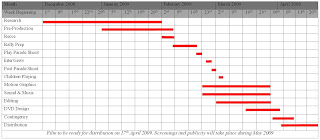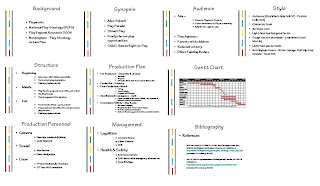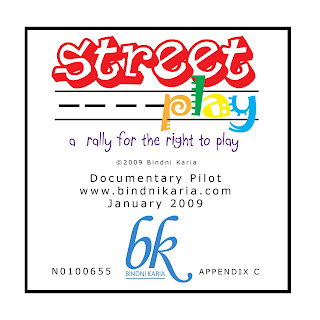- Why did you choose to study Multimedia? Did you always think you would? What kind of subjects did you study at school and college?
- What considerations, thoughts and concerns did you have about studying Multimedia? Did you think it would be technical, creative or both? Did you ever consider it a boy's subject?
- Do you think there are well known and recognised women in the Multimedia Industry? Do you know their names? Are they established?
- I have seen various women's' names in credits etc however they don't seem to be as publicised. All the big names tend to be men to me, how do you feel about this?
- Do you idealise a woman artist / creator, do you look up to anyone as a role model? Has anyone's work influenced you so much to convince you to enter the industry?
- Do you feel intimidated when you are around technology? Does this change when there are more or less men around you?
- Do you feel challenged by technology?
- There have always been issues and debates about women in Science Engineering and Technology (SET). What do you have to say about that statement?
- It's actually women who take on roles that they are expected to. They stop themselves from climbing further up the ladder. It's their attitude and assumptions...not the society. What do you have to say about these statements? Do you think they're true?
- What profession do you see yourself in once you graduate? a) See yourself? b) Would like to be in? Are A and B the same?
- If A and B are different why do you think this is? The desirable seems to be unachievable? Do you have a back-up profession, why?
- Do you feel like you fulfil certain roles or are better at certain roles because you're expected to?
- Do you think women always deal with particular subjects or follow a certain style for example activism and feminism?
Tuesday, January 27, 2009
PRP: Artefact 1 - The Interview Questions
Below, are the questions I intend to ask the interviewees:
PRP: Artefact 1 - The Idea
For my first artefact I have decided to interview women Multimedia students at Nottingham Trent University. I will capture these interviews in audio format as a record of the test and also make notes as the questions are answered.
My aim is to achieve a deeper and varied understanding of women's thoughts and opinions of their representation in the industry as artists. I intend to have a dialogue with each interviewee and I expect all the answers to be different. Although my objective is to ask particular open ended questions, I intend to leave the conversation open to changes and expect to ask questions that have been lead to and provoked by their answers.
From the series of interviews I am expecting to find a 'thread' or a 'link' that connects each answer. This will lead me to the next artefact. I am expecting a common occurring theme in the answers although they will be based on personal experiences.
My aim is to achieve a deeper and varied understanding of women's thoughts and opinions of their representation in the industry as artists. I intend to have a dialogue with each interviewee and I expect all the answers to be different. Although my objective is to ask particular open ended questions, I intend to leave the conversation open to changes and expect to ask questions that have been lead to and provoked by their answers.
From the series of interviews I am expecting to find a 'thread' or a 'link' that connects each answer. This will lead me to the next artefact. I am expecting a common occurring theme in the answers although they will be based on personal experiences.
Research Via Practise - The Question
The aim of the second part of the research project is to present arguments, test them and present the conclusions via practise. This involves practically creating tests every six weeks in order to explore and investigate an argument or question.
For my artefacts I will be researching:
How have successful women multimedia artists managed to enter the industry and what provoked them to avoid or overcome the limitation commonly characterised as ‘the glass ceiling’?
For my artefacts I will be researching:
How have successful women multimedia artists managed to enter the industry and what provoked them to avoid or overcome the limitation commonly characterised as ‘the glass ceiling’?
Client Project - Gantt Chart
Below is a gantt chart that outlines my time management during this project. To summarise:

- Pre-production = December 08 & January 09
- Production = February 09
- Post-Production = March 09
- Contingency = April (week 1)
- Distribution & Evaluation = April (weeks 2-4)
- Screenings & Publicity = May 09

Client Proposal Presentation
For my presentation I started off by showing the pilot film to introduce the subject, establish the characters and also show the style I am aiming for. I then went through slides with key points about the proposal as a guide. I felt the presentation went well and my confidence in talking in front of groups of people is improving. I received the following feedback from staff and peers:


- Structure: define further in terms of what each section will represent. Instead of beginning, middle and end use establish subject and problem, climax, find solution, conclusion (what happens now) and resolution.
- Pilot was clear and concise, showed the subject and style well. Last shot of the pilot however was not good and should not have been used. The pilot represents your skills and ability and should therefore not include anything that is shot poorly.
- Ensure clarity of exact shots for the production crew.
- In the pilot some of the shots were not technically correct. Make sure interviews are done at eye-level and framed correctly.
- Ensure same aspect ratio is used for all filming. I had captured some of the footage in 4:3 and rectified this after handing in the proposal. I showed the corrected version for my presentation.
- Advised to use children as a means of telling the story, keep the theme running visually - giving children a voice - don't get carried away allowing adults to talk about play expectations and experiences.
Client Proposal - The Final Draft
The final proposal for my client proposal was a 30 page bound document to include the following sections:
 Writing the actual proposal was a lot easier than I had expected. Although I think this was only because I had done a lot of background research and 'preparation' for the proposal (for example the proposal organiser in Michael Rabiger's book).
Writing the actual proposal was a lot easier than I had expected. Although I think this was only because I had done a lot of background research and 'preparation' for the proposal (for example the proposal organiser in Michael Rabiger's book).
I found it very difficult to produce the budget as I lack skills on Excel, which is not good considering I want to go into Producing. I found it interesting however to find out professional rates for crew staff and prices for hiring equipment. In total the foretasted budget came to a grand total of £85,000. This is the cost for the entire production including salary, insurance, staff, pre-production, production, post-production and distribution. One of the largest cost I found was my salary (if the documentary was being produced commercially for broadcast).
Producing a detailed schedule was not only time-consuming but also difficult as certain aspects had to be decided. For example I used the Production Management Software Celtx to write a script, for which I needed to know precise details. The script then acted as a backbone to create a detailed schedule, scene summary, catalogue etc. Once all the main details were inserted the software efficiently produced reports, this indirectly saves time for the rest of the pre-production phase.
Ultimately the appendix items made up most of the proposal and supported the main written section. I enjoyed producing the proposal and it gave me an insight into aspects I wouldn't have otherwise thought of. Although the proposal had been handed in there is still a great deal of pre-production to do:
- Background & Introduction
- Synopsis
- Treatment
- Characters
- Locations
- Style & Format
- Structure
- Production Plan
- Budget
- Audience & Distribution
- Production Personnel
- Appendices
- A: Playworks Newsletter
- B: Play Parade flyer
- C: Work in progress DVD
- D: Location Photos
- E: Visualisations
- F: Script
- G: Scene Summary
- H: Detailed Shooting Schedule
- I: Detailed Budget
- J: Production Personnel Details
- K: Management & Legalities
- Bibliography
 Writing the actual proposal was a lot easier than I had expected. Although I think this was only because I had done a lot of background research and 'preparation' for the proposal (for example the proposal organiser in Michael Rabiger's book).
Writing the actual proposal was a lot easier than I had expected. Although I think this was only because I had done a lot of background research and 'preparation' for the proposal (for example the proposal organiser in Michael Rabiger's book).I found it very difficult to produce the budget as I lack skills on Excel, which is not good considering I want to go into Producing. I found it interesting however to find out professional rates for crew staff and prices for hiring equipment. In total the foretasted budget came to a grand total of £85,000. This is the cost for the entire production including salary, insurance, staff, pre-production, production, post-production and distribution. One of the largest cost I found was my salary (if the documentary was being produced commercially for broadcast).
Producing a detailed schedule was not only time-consuming but also difficult as certain aspects had to be decided. For example I used the Production Management Software Celtx to write a script, for which I needed to know precise details. The script then acted as a backbone to create a detailed schedule, scene summary, catalogue etc. Once all the main details were inserted the software efficiently produced reports, this indirectly saves time for the rest of the pre-production phase.
Ultimately the appendix items made up most of the proposal and supported the main written section. I enjoyed producing the proposal and it gave me an insight into aspects I wouldn't have otherwise thought of. Although the proposal had been handed in there is still a great deal of pre-production to do:
- Detailed call sheets for crew
- Recce of all locations
- Risk Assessment for all locations
- Obtain talent and location release plans
- Shot Lists
- Equipment Lists
- Production Briefing Meetings
Sunday, January 18, 2009
Client: Proposal Sections
- Cover Sheet
- Contents
- Synopsis
- Treatment - Background Information, Structure, Sequences, Theme, Style, Characters, Location, Format (Equipment), Voice, Point of View
- Storyboard
- Target Audience
- Distribution Plans
- Schedule of Works
- Budget
- Production Personnel
- Work-in-progress (WIP) - DVD
- Work-in-progress (WIP) - written description
Client: Proposal Organiser
In order to put my documentary into perspective and fully understand the subject I followed an organisational structure outlined by Michael Rabiger in his book Directing the Documentary. This tool included the following sections which forced me to think deeply about what kind of film I am about to make.
- Working Hypothesis - what do I believe in? how is this reflected in my film? what are the conflicts? what is the POV? What do I want the audience to feel?
- Topic & Exposition - the film's subject and background information
- Action sequences - characters that will appear, events and activities that will take place
- Main Characters
- Conflict
- Social Significance
- My motivation for making the film
- Audience, its knowledge and prejudices
- To-camera interviews
- Style
- Tone
- Structure
- Resolution
Tuesday, January 13, 2009
Multimedia Trip to London
We went to London yesterday to see the Indian Highway exhibition at the Serpentine Gallery. The exhibition was a lot smaller than I expected but very interesting. I really liked the collection of paintings by India's respected artist M.F. Husain, which depicts the history of India. I also visited the Tate Modern with a few friends. I did not have any expections and was amazed by some of the work showcased. I liked the piece 'Let a Thousand Roses Bloom' by Anslem Kiefer (2000) and also 'Thirty Pieces of Silver' by Cornelia Parker.
http://www.tate.org.uk/magazine/issue1/newacquisition.htm
http://kids.tate.org.uk/films/thirty-pieces-of-silver.shtm
http://www.tate.org.uk/magazine/issue1/newacquisition.htm
http://kids.tate.org.uk/films/thirty-pieces-of-silver.shtm
Sunday, January 11, 2009
Sketching in the Nature
Armita Shirazi is an MA Textile Design and Innovation student. She decided to do some work in the park as part of her project. She required a record of her process and asked me to produce and direct a video for her. This was a personal project through which I developed my camera operation and editing techniques. I found it challenging as I was working completely on my own however this also encouraged me to be creative and produce a piece of multimedia with minimal resources. Armita showed the final video to her tutors and also presented the last minute to the whole Art & Design MA group. This video will be used as part of her research and development as a digital sketch book.
Live Client - Rally Meeting
I attended a meeting on the 8th Jan 09 at Playworks with regards to the Rally that will be taking place in the February half term. This will be a big part of the documentary and will also be challenging to film. Through the meeting I discovered that the documentary can easily take shape of a common structured story to include a beginning middle and end. Although this kind of narrative structure is almost inevitable I do not want the outcome to be visually typical. This has made me think of ways in which I can create something that visually tells the narrative and emphasises the importance of 'play' without using common characteristics such as interviews. This is not only to make the documentary unique but to also support and compliment the underlying theme of children having 'freely chosen' play opportunities and therefore having their own voice to represent what they think play is.
Alice suggested that we could do a play session with the children about filming. I think this would be very interesting and could lead to shots and ways of telling the story that may not be achievable by an adult or student camera operator. However this would mean varied image quality and formats as the children would use a normal miniDV compared to a HD Camera.
The idea of allowing the children to tell the story of play has made me consider splitting the documentary into two parts:
1. What is play?
2. What is the Street Play Project? = Alice and the Rally
These two areas fit together well, part 1 establishes the subject and introduces the problem. Part 2 finds a solution through the character Alice Sidwell and resolves the problem through the rally as the launch of street play. However the story has to be constructed precisely in order for the parts to flow into eachother.
Alice suggested that we could do a play session with the children about filming. I think this would be very interesting and could lead to shots and ways of telling the story that may not be achievable by an adult or student camera operator. However this would mean varied image quality and formats as the children would use a normal miniDV compared to a HD Camera.
The idea of allowing the children to tell the story of play has made me consider splitting the documentary into two parts:
1. What is play?
2. What is the Street Play Project? = Alice and the Rally
These two areas fit together well, part 1 establishes the subject and introduces the problem. Part 2 finds a solution through the character Alice Sidwell and resolves the problem through the rally as the launch of street play. However the story has to be constructed precisely in order for the parts to flow into eachother.
Subscribe to:
Comments (Atom)




